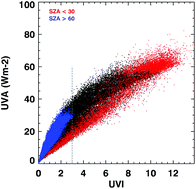当前位置:
X-MOL 学术
›
Photochem. Photobiol. Sci.
›
论文详情
Our official English website, www.x-mol.net, welcomes your feedback! (Note: you will need to create a separate account there.)
Are current guidelines for sun protection optimal for health? Exploring the evidence†
Photochemical & Photobiological Sciences ( IF 3.1 ) Pub Date : 2018-06-15 00:00:00 , DOI: 10.1039/c7pp00374a Robyn M. Lucas 1, 2, 3, 4, 5 , Rachel E. Neale 5, 6, 7 , Sasha Madronich 8, 9, 10 , Richard L. McKenzie 11, 12, 13, 14
Photochemical & Photobiological Sciences ( IF 3.1 ) Pub Date : 2018-06-15 00:00:00 , DOI: 10.1039/c7pp00374a Robyn M. Lucas 1, 2, 3, 4, 5 , Rachel E. Neale 5, 6, 7 , Sasha Madronich 8, 9, 10 , Richard L. McKenzie 11, 12, 13, 14
Affiliation

|
Exposure of the skin to ultraviolet (UV) radiation is the main risk factor for skin cancer, and a major source of vitamin D, in many regions of the world. Sun protection messages to minimize skin cancer risks but avoid vitamin D deficiency are challenging, partly because levels of UV radiation vary by location, season, time of day, and atmospheric conditions. The UV Index provides information on levels of UV radiation and is a cornerstone of sun protection guidelines. Current guidelines from the World Health Organization are that sun protection is required only when the UV Index is 3 or greater. This advice is pragmatic rather than evidence based. The UV Index is a continuous scale; more comprehensive sun protection is required as the UV Index increases. In addition, a wide range of UVA doses is possible with a UVI of 3, from which there may be health consequences, while full sun protection when the UVI is “moderate” (between 3 and 5) may limit vitamin D production. Finally, the duration of time spent in the sun is an essential component of a public health message, in addition to the intensity of ambient UV radiation as measured by the UV Index. Together these provide the dose of UV radiation that is relevant to both skin cancer genesis and vitamin D production. Further education is required to increase the understanding of the UV Index; messages framed using the UV Index need to incorporate the importance of duration of exposure and increasing sun protection with increasing dose of UV radiation.
中文翻译:

当前的防晒准则是否最适合健康?探索证据†
在世界许多地区,皮肤暴露于紫外线(UV)辐射是皮肤癌的主要危险因素,也是维生素D的主要来源。尽量减少皮肤癌风险但避免维生素D缺乏的防晒信息具有挑战性,部分原因是紫外线辐射的水平随位置,季节,一天中的时间和大气条件而变化。紫外线指数提供有关紫外线辐射水平的信息,并且是防晒准则的基石。世界卫生组织的现行准则是,仅当紫外线指数为3或更大时才需要防晒。该建议是务实的,而不是基于证据的。紫外线指数是一个连续的标度。随着紫外线指数的增加,需要更全面的防晒。此外,UVI为3时,可能会出现各种UVA剂量,从中可能会产生健康后果,而当UVI为“中等”(3至5)时,充分的防晒可能会限制维生素D的产生。最后,除了通过紫外线指数测量的环境紫外线辐射强度外,在阳光下度过的时间是公共卫生信息的重要组成部分。这些共同提供了与皮肤癌的发生和维生素D产生相关的紫外线辐射剂量。需要进一步的教育以增加对紫外线指数的了解;使用“紫外线指数”构成的信息需要考虑到暴露时间的重要性以及随着紫外线辐射剂量的增加而增加防晒的重要性。除了通过紫外线指数测量的环境紫外线辐射强度外,在阳光下度过的时间是公共卫生信息的重要组成部分。这些共同提供了与皮肤癌的发生和维生素D产生相关的紫外线辐射剂量。需要进一步的教育以增加对紫外线指数的了解;使用“紫外线指数”构成的信息需要考虑到暴露时间的重要性以及随着紫外线辐射剂量的增加而增加防晒的重要性。除了通过紫外线指数测量的环境紫外线辐射强度外,在阳光下度过的时间是公共卫生信息的重要组成部分。这些共同提供了与皮肤癌的发生和维生素D产生相关的紫外线辐射剂量。需要进一步的教育以增加对紫外线指数的了解;使用“紫外线指数”构成的信息需要考虑到暴露时间的重要性以及随着紫外线辐射剂量的增加而增加防晒效果的重要性。
更新日期:2018-06-15
中文翻译:

当前的防晒准则是否最适合健康?探索证据†
在世界许多地区,皮肤暴露于紫外线(UV)辐射是皮肤癌的主要危险因素,也是维生素D的主要来源。尽量减少皮肤癌风险但避免维生素D缺乏的防晒信息具有挑战性,部分原因是紫外线辐射的水平随位置,季节,一天中的时间和大气条件而变化。紫外线指数提供有关紫外线辐射水平的信息,并且是防晒准则的基石。世界卫生组织的现行准则是,仅当紫外线指数为3或更大时才需要防晒。该建议是务实的,而不是基于证据的。紫外线指数是一个连续的标度。随着紫外线指数的增加,需要更全面的防晒。此外,UVI为3时,可能会出现各种UVA剂量,从中可能会产生健康后果,而当UVI为“中等”(3至5)时,充分的防晒可能会限制维生素D的产生。最后,除了通过紫外线指数测量的环境紫外线辐射强度外,在阳光下度过的时间是公共卫生信息的重要组成部分。这些共同提供了与皮肤癌的发生和维生素D产生相关的紫外线辐射剂量。需要进一步的教育以增加对紫外线指数的了解;使用“紫外线指数”构成的信息需要考虑到暴露时间的重要性以及随着紫外线辐射剂量的增加而增加防晒的重要性。除了通过紫外线指数测量的环境紫外线辐射强度外,在阳光下度过的时间是公共卫生信息的重要组成部分。这些共同提供了与皮肤癌的发生和维生素D产生相关的紫外线辐射剂量。需要进一步的教育以增加对紫外线指数的了解;使用“紫外线指数”构成的信息需要考虑到暴露时间的重要性以及随着紫外线辐射剂量的增加而增加防晒的重要性。除了通过紫外线指数测量的环境紫外线辐射强度外,在阳光下度过的时间是公共卫生信息的重要组成部分。这些共同提供了与皮肤癌的发生和维生素D产生相关的紫外线辐射剂量。需要进一步的教育以增加对紫外线指数的了解;使用“紫外线指数”构成的信息需要考虑到暴露时间的重要性以及随着紫外线辐射剂量的增加而增加防晒效果的重要性。



























 京公网安备 11010802027423号
京公网安备 11010802027423号